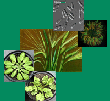| Weber, M; Beyene, B; Nagler, N; Schempp, S; Herfert, J; Klecker, M; Clemens, S: A mutation in the essential and widely conserved DAMAGED DNA BINDING1-Cullin4 ASSOCIATED FACTOR gene OZS3 causes hypersensitivity to zinc excess, cold and UV stress in Arabidopsis thaliana., Plant Journal (2020), doi:10.1111/tpj.14779 | |
| Abstract: The overly zinc sensitive Arabidopsis thaliana mutant ozs3 shows reduced growth of the primary root which is exacerbated by an excess specifically of Zn ions. In addition, ozs3 plants display various subtle developmental phenotypes such as longer petioles and early flowering. Also, ozs3 seedlings are completely but reversibly growth-arrested when shifted to 4 °C. The causal mutation was mapped to a gene encoding a putative substrate-recognition receptor of cullin4 E3 ligases. OZS3 orthologous genes can be found in nearly all eukaryotic genomes. Most species from Schizosaccharomyces pombe to Homo sapiens, and including A. thaliana, possess one ortholog. No functional data are available for these genes in any of the multicellular model systems. CRISPR-Cas9-mediated knock-out demonstrated that a complete loss of OZS3 function is embryo-lethal, indicating essentiality of OZS3 and its orthologs. The OZS3 protein interacts with the adaptor protein DAMAGED DNA BINDING1 (DDB1) in the nucleus. Thus, it is indeed a member of the large yet poorly characterized family of DDB1-cullin4 associated factors (DCAFs) in plants. Mutant phenotypes of ozs3 plants are apparently caused by the weakened DDB1-OZS3 interaction due to the exchange of a conserved amino acid near the conserved WDxR motif. |

